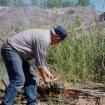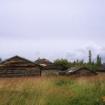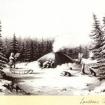By Type
Northern ground cone
White Moss (Reindeer lichen)
This lichen grows in large mats in spruce forests, where it is often eaten by caribou. According to Alfred Semple, Lazarus Sittichinli said it takes a long time to grow. He also told Alfred that if you eat animals that eat willow, like moose, you will get hungry more quickly than eating animals that eat lichen, like caribou. William Teya said, as children, they were taught to respect the lichen. Children were not supposed to play on it and if you took some, you were to pay for it.
Moss (sphagnum moss)
Puffballs
As medicine
The brown powder inside the puffballs fungi is used to treat weeping sores when there are no bandages to cover the area. The powder is also used on burns when the blister has broken and the burn area is weepy. The powder is dusted over the affected area. It will dry the area so infection does not set in.
Source: Andre, Alestine, Nan t'aih nakwits'inahtsìh (The Land Gives Us Strength) (2006)
Birch and Willow fungus
Yarrow
As medicine
Wormwood
Wintergreen
As medicine
Ruth Welsh’s mother taught her to use wintergreen or large-flowered wintergreen for pain. The leaves of this plant can be used all winter. Ruth said,
...you know where [the wintergreen] patches are and you dig the snow away, brush the last of the snow away from the plants, and you can still pick the leaves.
Silverweed
It thickens the blood and it's a coagulant...therefore when you're bleeding pretty good, you drink the tea from this, or if you suspect internal bleeding and you don't have the yarrow...



